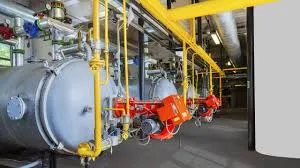
مارس . 04, 2025 10:32 Back to list
Biomass fired steam boiler
Building a boiler for a steam engine is a task that merges engineering, craftsmanship, and a deep understanding of thermodynamics. Such a project not only fosters personal growth in mechanical excellence but also enhances one’s expertise in sustainable energy solutions. This guide provides an innovative approach, combining precise engineering with safety protocols, for crafting a unique and functional boiler.
1. Safety First Before construction begins, ensure all safety measures are in place. Acquire protective gear, set up emergency procedures, and ensure your work area is clear of combustible items. 2. Fabricating the Pressure Vessel Begin with rolling or welding the steel into a cylindrical shape, ensuring airtight seals to prevent steam leaks. For amateurs, using pre-fabricated steel drums can simplify construction without compromising safety. 3. Integrating the Heat Source Securely attach the chosen heat source. For coal-fired designs, construct a robust furnace with controlled airflow. In electric models, install elements with proper insulation to prevent energy loss. 4. Installing Safety Features Safety valves are imperative to manage excess pressure. These should be calibrated correctly and frequently tested. A pressure gauge is also essential to monitor boiler pressure continuously. 5. Water Feed System Integrate a water feed pump and reservoir. This system should maintain a steady flow of water into the boiler, compensating for water turned into steam. Automated electronic pumps can enhance the reliability of water feeding. Testing and Maintenance Initial Testing Before introducing the boiler to full operational conditions, conduct a hydrostatic test. Fill the boiler with water, increasing the pressure slowly to check for leaks or structural weaknesses. Ensure all seals and joints hold firm under pressure. Routine Inspections Regular inspection and maintenance are vital. Clean the boiler regularly to remove scale and soot, which can impede heat transfer. Check and recalibrate safety valves periodically. Also, conduct annual inspections of all structural and operational elements. Final Thoughts Building a boiler demands not just technical ability but a commitment to safety and precision. Although this guide provides a foundational approach, always be willing to seek further expertise and advice from professional engineers, particularly for more complex applications. By adhering to industry standards and prioritizing safety, you can create an efficient, reliable, and innovative steam engine boiler system. This not only fosters a deeper connection to the mechanics of steam power but also contributes to the ever-evolving landscape of sustainable mechanical engineering.


1. Safety First Before construction begins, ensure all safety measures are in place. Acquire protective gear, set up emergency procedures, and ensure your work area is clear of combustible items. 2. Fabricating the Pressure Vessel Begin with rolling or welding the steel into a cylindrical shape, ensuring airtight seals to prevent steam leaks. For amateurs, using pre-fabricated steel drums can simplify construction without compromising safety. 3. Integrating the Heat Source Securely attach the chosen heat source. For coal-fired designs, construct a robust furnace with controlled airflow. In electric models, install elements with proper insulation to prevent energy loss. 4. Installing Safety Features Safety valves are imperative to manage excess pressure. These should be calibrated correctly and frequently tested. A pressure gauge is also essential to monitor boiler pressure continuously. 5. Water Feed System Integrate a water feed pump and reservoir. This system should maintain a steady flow of water into the boiler, compensating for water turned into steam. Automated electronic pumps can enhance the reliability of water feeding. Testing and Maintenance Initial Testing Before introducing the boiler to full operational conditions, conduct a hydrostatic test. Fill the boiler with water, increasing the pressure slowly to check for leaks or structural weaknesses. Ensure all seals and joints hold firm under pressure. Routine Inspections Regular inspection and maintenance are vital. Clean the boiler regularly to remove scale and soot, which can impede heat transfer. Check and recalibrate safety valves periodically. Also, conduct annual inspections of all structural and operational elements. Final Thoughts Building a boiler demands not just technical ability but a commitment to safety and precision. Although this guide provides a foundational approach, always be willing to seek further expertise and advice from professional engineers, particularly for more complex applications. By adhering to industry standards and prioritizing safety, you can create an efficient, reliable, and innovative steam engine boiler system. This not only fosters a deeper connection to the mechanics of steam power but also contributes to the ever-evolving landscape of sustainable mechanical engineering.
Share
Latest News
-
High-Efficiency Commercial Oil Fired Steam Boiler for Industry
NewsJul.30,2025
-
High-Efficiency Biomass Fired Thermal Oil Boiler Solutions
NewsJul.30,2025
-
High Efficiency Gas Fired Thermal Oil Boiler for Industrial Heating
NewsJul.29,2025
-
High-Efficiency Gas Fired Hot Water Boiler for Sale – Reliable & Affordable
NewsJul.29,2025
-
High Efficiency Biomass Fired Hot Water Boiler for Industrial and Commercial Use
NewsJul.29,2025
-
High-Efficiency Biomass Fired Hot Water Boiler for Industrial Use
NewsJul.28,2025
Related PRODUCTS
Copyright © 2025 HEBEI HONGZE BOILER MANUFACTURING CO., LTD. All Rights Reserved. Sitemap | Privacy Policy






















